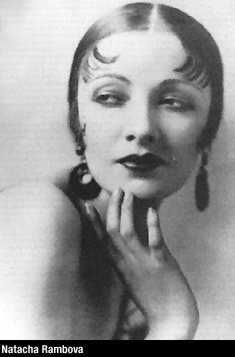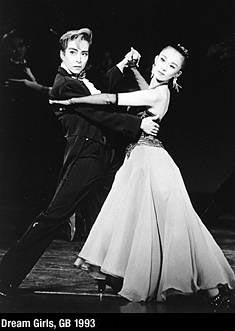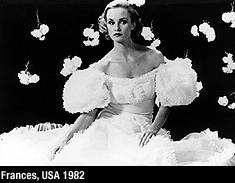5th. International Women's Film Festival 1995
A Scandalous State of Affairs-
A Look behind the Scenes
Introduction:
Moviemaking is the interaction of many different factors. Everyone involved in this process contributes her specific knowledge, her specific view of the world and her specific idea of what exactly is to be brought over to the audience in the form of images, sound, costumes, scenes and language. The final result is a film we either appreciate or reject.
"The film is over; let's have look at the credits." That was the first programme announcement we made for the 1995 festival and took, in fact, a closer look at those areas which have previously been perceived with only peripheral vision by filmgoers and, to a certain extent, by critics as well. Although this is not specifically a woman's problem, this non-perception affects women more than it does men. In this respect, nothing has changed since 1987 when we called attention to this trend at the first femme totale festival.
A chronicle of images, passion, daring and scandals would be one fitting description for the first century of the cinema and we have been showing some of all that at the Festival in our alternative chronicle -- a survey of neglected or undiscovered women artists and various scandals as lived and experienced by different women.
Wherever the centenary of the cinema was celebrated in 1995, we encountered well-known names and names that are less well known. This is quite understandable: like every other art form, the cinema has a special character which only comes alive as the result of diversified forms of expression. "Big names" were represented at this year's festival, of course but they were not always recognised as such; more often than not, it took an explanatory sentence after the name to elicit a relieved "Oh, yes! Well, then ..." Who has heard of the filmmaker Matilde Landeta, for example? And who can associate anything with the name Natacha Rambova? Who knows how many women composers of film music there are and who can list off their names? Who believes women have the stuff it takes to make westerns and who believes that they can fight back as well? The vast majority of the filmmakers in Latin America, India and other countries in the so-called Third World are virtually unknown to us here in Central Europe.
We illuminated the film productions of the past century - and of the present day - from several different points of view.
There is hardly any other aspect of filmmaking that puts such a perfect machinery of illusion into gear as the sets and scenery branch. The sets we see in films - nature, buildings, streets and interiors - are often copies of real settings; they have been painted to look like the originals and then built and erected in gigantic film studios. At this festival, we intended to lift a tiny corner of that "magical cloth" and ventured a glimpse behind the scenes.
Costume design is a completely different matter. It is obvious that costumes are always associated to a certain extent with masquerade. The persons who wear them slip into someone else's skin: they are playing a role. The entire spectrum of "costuming" art was represented at the festival by an exhibition of costumes from both historical and current film productions. In addition, there were workshops on this subjects, where women costume designers talked about their work.
Composing music for films and wielding the camera are, as ever, occupations still not considered women's work. There are women active in both of these disciplines, however, and we had a chance to hear and see the results at the festival.
But it is not only the different members of the film team who were heard; the language of film came under scrutiny at the festival. In addition to the real women of flesh and blood who appeared in our programme with their cameras and conductor's batons, we met several imaginary women of celluloid, cult figures of the screen in both mainstream and off-mainstream films. No history of the cinema would be complete without the "bitches", extraordinary women all: revenge-driven murderesses, capricious screen goddesses, starlets with the airs and graces of a star. They are at home in any genre and even more so in the history of film. No wonder Kenneth Anger gave the programmatic title Hollywood Babylon to his collection of censorship cases, dramatic scandals and star antics.
That this type of cinema - with evil women ý la Bette Davis, sharp-tongued glamour pusses · la Mae West and tragic figures such as Frances Farmer - should both fascinate and influence the independent cinema scene is not just illustrated by the case of cult director Kenneth Anger. In its special film retrospective A Scandalous State of Affairs, femme totale reviewed some of the ebullient ambivalent figures in whom mainstream cinema has retained a residue of subversion -- film figures who tend to dominate the many fringe festivals held all over the world: stroppy actresses, demi-monde divas, banditas, guerilleras, female vampires and not least cowgirls. We screened, by the way, the first ever female western.
Our aim here was to draw attention to these wonderfully scandalous women and, at the same
time, break with the constructs of that very attention. Two films were centered around
this idea, two films that critically illuminated each other and rendered any ultimate
pinning down impossible. The documentary perspective, for instance, broke down the
heroism of the female rebel typical for feature films without, however, losing track of
her glamour and attractivity. To ensure that our look behind the scenes of alternative
cinema was not restricted to Hollywood and Europe, we also showed examples of films made
by nonconformist, indeed eccentric, women from Latin America and Asia.
![]()

The Main topics of the Festival:
A Look behind the Scene
The Screen as Catwalk: Costume Design
When Women set the Tone: Film Music
The Building of Illusions: Scenery and Set Design
Camera Adventure: Camerawoman Jolanta Dylewska
Cult Figures from Hollywood and elsewhere
Banditas: The Case of Phoolan Devi
Viva La Diva! Stars and Eccentric Women Artists
Rebel Women: Two Ways of Viewing Exceptional Women
From Bonanza to Bad Girls: Women in the Western
Shocking Pink! Creating a History of Lesbian Cinema
The Screen as Catwalk: Costume Design
Cinema is an eldorado for dressing up. Here fashion unfolds its narrative talents and the screen becomes a catwalk.Femme totale showed the now historical partner mix-up comedy Why change your wife? which, although made in 1920, receved its German premiere at the Festival. The costumes for the production - born under the sign of sex, sets and costumes - were designed by Clare West and Natacha Rambova. Current models by two other costume designers also helped broaden out the topic further. We showed films from the Czech costume and set designer, screenplay author and director Esther Krumbachov and from the extensive filmography of English costume designer Shirley Russell.
Films:
Camille
USA 1921, 62 min, Ray C. Smallwood, Costumes: Natacha Rambova
Der Mord am Ingenieur Teufel
CSSR 1970, 71 min, Ester Krumbachov
Die Teufel
GB 1970, 111 min, Ken Russell, Costumes: Shirley Russell
Salomé
USA 1923, 45 min, Charles Bryant, laut Zeitzeugen: Natacha Rambova, Alla Nazimova, Scripts/Costumes/Set-Design: Natacha Rambova
Valentino
GB 1976, 127 min, Ken Russell, Costumes: Shirley Russell
Why change Your Wife
USA 1920, 80 min, Cecil B. DeMille, Costumes: Natacha Rambova
Ballad of little Jo
USA 1993, 121 min, Maggie Greenwald, Costumes: Claudia Brown
Darüber spricht man nicht
Argentinien/Italy 1993, 102 min, Maria Luisa Bemberg, Costumes: Graciela Galn
Florence Foster Jenkins
BRD/USA 1994, 7 min, Birgit Lehmann, Costumes: Ulla Birkelbach
Gespräch mit dem Mann im Schrank
PL 1993, 94 min, Mariusz Grzegorzek, Costumes: Izabela Balinska, Anna Kowalska
Hochzeitsgäste
BRD/PL 1993, 40 min, Niko Brücher, Costumes: Elzbieta Radke
Olivia
F 1951, 96 min, Jacqueline Audry, kostüme: Mireille Leydet
Wenn es Nacht wird
CAN 995, Patricia Rozema, Costumes: Linda Muir

When Women set the Tone: Film Music
Music imbues the film with an added dimension to convey atmosphere, emotion or even smell -- anything that cannot be put across by images alone. Film music addresses the audience or the viewer at a level they are probably not fully aware of. In some scenes, the music expresses what the pictures can only imply or fail to convey: the feelings and thoughts of the characters.
We presented women who have gained a reputation for themselves by setting the music to sophisticated films such as Used People (directed by Beeban Kidron, music by Rachel Portman). And women engaged on experimental/electronic music.
Films:
Abbie Conant - Allein unter Männern
BRD 1994, Brenda Parkerson
Herbstzeitlose
USA 1991, Beeban Kidron, Music: Rachel Portman
Die Höhenflüge des Wladimir Tatlin
R 1994, Elena Raktin, Music and Tone: Anna Ikramova
Miracle - Ein geheimnisvoller Sommer
GB 1990, Regie and Scripts: Neil Jordan, Music: Anne Dudley
Ein Tag länger als die Nacht
UdSSR 1984, Regie: Lana Gogoberidse, Music: Gija Kantscheli, Manana Menabde (Lieder)
Florence Foster Jenkins
BRD/USA 1994, 7 min, Birgit Lehmann, Music: Florence Foster Jenkins
Geliebte Mörderin
BRD 1992, Heidi Kull
Gespräch mit dem Mann im Schrank
PL 1993, 94 min, Mariusz Grzegorzek, Music: Kronos Quartett, Esther Lamandier, Piotr Szzepanik
Perception/Tension
CH 1991, 10 min, Gitta Gsell, Music: Juliana Müller, Ruth Bieri
Superhero
USA 1995, 10 min, Mara Mattuschka, Tone: Mara Mattuschka
Tausend Küsse an Wanda
BRD 1994, 22 min, Eva Heldmann, Music: Elvira Plenar
Two Queens Meeting
E 1988, Cecilia Barriga, Music: Edith Salazar
Weil das Auge Ohren fiel
BRD 1993, Susu Grunenberg, Music: Sharron Savyer

The Building of Illusions: Scenery and Set Design
The art of film is the art of images. Scenery and set design play a key role. Visual ideas do not merely illustrate the plot; they have a narrative of their own.
In early film productions, there are numerous examples of artistically high-quality sets by pioneering women designers, like Natacha Rambova. Though perhaps they have not merited the attention they deserve in Germany, they are now waiting to be discovered. From the Czech costume/set designer, screenplay author and director Ester Krumbachov were shown the two films.
Films:
Camille
USA 1921, 62 min, Ray C. Smallwood, Set Design: Natacha Rambova
Der Mord am Ingenieur Teufel
CSSR 1970, 71 min, Ester Krumbachov
Salomé
USA 1923, 45 min, Charles Bryant, laut Zeitzeugen: Natacha Rambova, Alla Nazimova, Set Design: Natacha Rambova
Tausendschönchen / Sedmikrasky
CSSR 1966, 76 min, Vera Chytilov
Alma Punk
Mexico 1991, 57 min, Sarah Minter, Set Design: Paula Carpa
Ballad of little Jo
USA 1993, 121 min, Maggie Greenwald, Set Design: Stephanie Caroll
Battement
R 1994, 10 min, Marina Drozdova, Set Design: Galina Odikaevsky, Igor Timoshenko
Daphne
BRD 1993, 6 min, Dorotha Körner, Set Design: Stephanie Körner
Florence Foster Jenkins
BRD/USA 1994, 7 min, Birgit Lehmann, Set Design: Barbara Schork

Camera Adventure: Camerawoman Jolanta Dylewska
Women are still underrepresented in terms of numbers. The profession as a whole continues to be considered a male domain - that of cameraman - and women find it difficult to wrest recognition.
Nonetheless, women are now winning international acclaim for their work as camera technicians. We settled on Jolanta Dylewska -- a camera technician who lives and works in Lodz and whose films we will be showing in some detail.
Films:
Gespräch mit dem Mann im Schrank
PL 1993, 94 min, Mariusz Grzegorzek, Camera: Jolanta Dylewska
Hochzeitsgäste
BRD/PL 1993, 40 min, Niko Brücher, Camera: Jolanta Dylewska
Maries Lied
BRD/PL 1994, 90 min, Regie: Niko Brücher, Camera: Jolanta Dylewska
Alma Punk
Mexico 1991, 57 min, Sarah Minter, Camera: Sarah Minter
Anna und Edith
BRD 1975, 77 min, Gerrit Neuhaus, Camera: Nurith Aviv, Heinriette Loch
Daphne
BRD 1993, 6 min, Dorotha Körner, Camera: Dorothea Körner
Dream Girls
GB 1993, 50 min, Regie: Kim Longinotto, Jano Williams, Camera: Kim Longinotto
Geliebte Mörderin
BRD 1992, 7 min, Heidi Kull, Camera: Heidi Kull
Guerillas in Our Midst
USA 1992, 35 min, Amy Harrison, Camera: Ellen Kuras
Die Höhenflüge des Wladimir Tatlin
R 1994, 33 min, Elena Raktin, Camera: Monika Pirch, Aleksej Naidenow
Phoolan Devi - Rebellion einer Banditin
BRD 1994, 80 min, Mirjam Quinte, Camera: Mirjam Quinte, Satheesh Narayon
SOS Extraterrestria
A 1993, 16 min, Mara Mattuschka, Camera: Ulla Barthold
Tausend Küsse an Wanda
BRD 1994, 22 min, Eva Heldmann, Camera: Eva Heldmann
Weil das Auge Ohren fiel
BRD 1993, 22 min, Susu Grunenberg, Camera: Susu Grunenberg

Historic Film Matinee: SALOMÉ
The historic film matinée 1995 Matinée highlighted positively eccentric (women) personalities - an epithet which applied to set designer Natacha Rambova, on whom here the limelight shined, and to the New Testament figure of Salomé.
Films:
Salomé
I 1913, 9 min, Ugo Falena
Salomé
USA 1923, 45 min, Charles Bryant, laut Zeitzeugen: Natacha Rambova, Alla Nazimova, Scripts/Costumes/Set-Design: Natacha Rambova

Banditas: The Case of Phoolan Devi
The events surrounding Phoolan Devi became one of those news items from India that occasionally causes a furore in here in Europe. The two films chosen for this festival opened up different perspectives on the life and character of Phoolan Devi. The feature film BANDIT QUEEN and the documentary PHOOLAN DEVI both attempt to get close to this at once politically topical and already legendary woman - but with completely different approaches.
Films:
Bandit Queen
Indien 1994, 119 min, Shekhar Kapur, Scripts: Mala Sen
Phoolan Devi - Rebellion einer Banditin
BRD 1994, 80 min, Mirjam Quinte

Viva La Diva! Stars and Eccentric Women Artists
What exactly is a screen goddess, a diva? Well, the silent film age produced a good dozen of them and the 1930s/1940s immortalised quite a few as well: Louise Brooks, Greta Garbo, Marlene Dietrich. A "screen goddess" or "diva" might usefully be defined as an amalgam of glamour, rumours, a certain element of mystery, lots of affairs (preferably, as in the case of Garbo, with men and women) and a very extensive wardrobe. And what is a diva today? Are there any still around or is this flamboyant breed of star and self-projection now extinct?
femme totale took a look at these charismatic stars by means of documentary and feature films that should highlight both sides of the coin: (a) the huge demands placed on such personalities by the combined forces of market pressure, media attention and star system expectations; and (b) the dissidence.
Films:
Committed
USA 1980-84, 77 min, Sheila McLaughin, Lynne Tillman
Frances
USA 1982, 140 min, Graeme Clifford, Darstellung: Jessica Lang
Dream Girls
GB 1993, 50 min, Kim Longinotto, Jano Williams
Kloss im Hals / Nodo alla Gola
I 1992, 7 min, Gisella Penazzi
Prix de Beauté - Miss Europe
F 1930, 92 min, Augusto Genina, Darstellung: Louise Brooks anda.
Sandra Bernhard - Confessions of a Pretty Lady
IGB 1993, 46 min, Kristiene Clarke, Produzentin: Sarah Mortimer
Two Queens Meeting
E 1988, 14 min, Cecilia Barriga
Battement
R 1994, 10 min, Marina Drozdova
Ella Cinders
USA 1926, 65 min, Alfred E. Green
Elles
GB 1991, 3 min, Joanna Quinn
Girls Night Out
GB 1987, 6 min, Joanna Quinn
Ein Konglomerat
BRD 1994, 9 min, Ira Zamjatnins
Mensahib Rita
GB 1994, 20 min, Pratibha Parmar
Salomé
I 1913, 9 min, Ugo Falena
Salomé
USA 1923, 45 min, Charles Bryant, Natacha Rambova, Alla Nazimova
Die Teufel
GB 1970, 111 min, Ken Russell
SOS Extraterrestra
A 1993, 10 min, Mara Mattuschka

Rebel Women: Two Ways of Viewing Exceptional Women
Rebels, guerrillas and terrorists of the female kind are right at the top of the Richter scale of horrifying, intimidating and eccentric womanhood.
We presented two rebel women templates:
The first originates with women and
The second couldn't be more contrasting.
LA NEGRA ANGUSTIAS is a melodrama from the late 1940s made by a pioneer of Latin American cinema, the Mexican Matilde Landeta.Some forty years later, on the other hand, MARIA'S STORY depicts the nonheroic everyday of a rebel woman in El Salvador from the documentary perspective.
Films:
La Negra Angustias (The Black Angustias)
Mexiko 1949, 81 min, Matilde Landeta
Maria's Story
USA/El Salvador 1990, 53 min, Monona Wali, Pamela Cohen

From Bonanza to Bad Girls: Women in the Western
With its heros reeking of horse and leather, the typical cowboy film is probably the most manly of all genres. The "Women in Western" part of our programme therefore put the spotlight on the very first western to be made by a woman - FORTY-NINE SEVENTEEN - and also on THE BALLAD OF LITTLE JO, a heroine who never achieved the fame of such legendary characters as Calamity Jane but whose story, like that of Calamity Jane, was based on fact.
Films:
Forty-Nine-Seventeen
USA 1917, 53 min, Ruth Ann Baldwin
The Ballad of Little Jo
USA 1913, 121 min, Maggie Greenwald
Bullchix
BRD 1994, 15 min, Carolin Otterbach

Shocking Pink! Creating a History of Lesbian Cinema
The struggle of lesbian culture for recognition reflects like hardly any other the search for a legitimate existence beyond the standards of the norm. The need for new forms of identity presupposes that cultural patterns, definitions of identity and the overstepping of society's arbitrary lines be examined and continuously re-examined. Films and videos have a major role to play in this process.
Films:
A Florida Enchantment
USA 1914, 63 min, Sidney Drew
Anna und Elisabeth
D 1933, 64 min, Frank Wysbar
Anna und Edith
BRD 1975, 77 min, Gerrit Neuhaus
Olivia
F 1951, 96 min, Jacqueline Audry
Blut an den Lippen
BRD/B/F 1970, 89 min, Harry Krümel
Das Leben ist eine Frau (Schizn-Schenschtschina)
Kasachstan 1992, 82 min, Schanna Serikbajewa
Wenn es Nacht wird
CAN 1995, 93 min, Patricia Rozema
![]()
